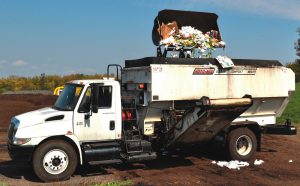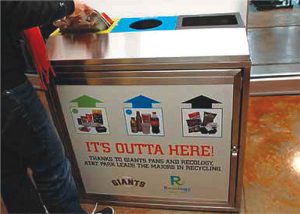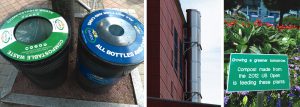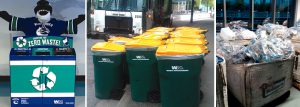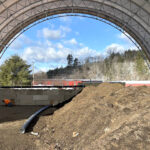In the sports greening arena, the adoption of recycling and composting programs is proceeding at an increased pace. To ensure efficient and effective implementation, buy-in must occur at all levels of an organization, starting at the top.
Nate Clark
BioCycle June 2014
 In the business of professional and collegiate sports, with top priority on championships, player injuries, and filling stadium seats, attending a meeting with Martin Tull, Executive Director of the Green Sports Alliance (Alliance), seems like a walk in the ballpark. “When we speak to potential members, we often say, ‘Would you like to know how other teams are saving millions of dollars through conservation programs?’” states Tull. “Almost always they answer, ‘Yes! We would like to know more!’” Increasingly, more and more teams are finding it harder to turn down what Tull and the Alliance have to offer.
In the business of professional and collegiate sports, with top priority on championships, player injuries, and filling stadium seats, attending a meeting with Martin Tull, Executive Director of the Green Sports Alliance (Alliance), seems like a walk in the ballpark. “When we speak to potential members, we often say, ‘Would you like to know how other teams are saving millions of dollars through conservation programs?’” states Tull. “Almost always they answer, ‘Yes! We would like to know more!’” Increasingly, more and more teams are finding it harder to turn down what Tull and the Alliance have to offer.
The Natural Resources Defense Council (NRDC) and Vulcan Sports and Entertainment (a division of Paul G. Allen’s Vulcan Inc. which owns the Seattle Seahawks, Seattle Sounders, and Portland TrailBlazers) founded the Alliance in 2010 with a stated mission, “to help enhance the environmental performance of sports teams, venues and leagues.” In just three years after the national launch, Alliance membership has grown from six teams to over 230 professional and collegiate sports teams and venues, representing nearly half of all teams in all professional leagues in the United States.
The Alliance promotes environmental initiatives, ranging from nontoxic and effective cleaning solutions for venues, to alternative transportation for getting fans to and from games. One area of sports greening that has seen a lot of recent growth is recycling and composting programs at sports venues. The Alliance assists members with implementation of necessary program components in coordination with organizations like the NRDC and representatives from supporting industries, such as the compostable products industry. In March 2014, Darby Hoover, NRDC Senior Resource Specialist, authored the Guide to Composting at Sports Venues. The guide provides step-by-step advice on establishing or expanding organics recycling programs at sports venues, utilizing case studies and profiles to exhibit how various teams have developed strategies for making organics recycling work at their venue. Steve Davies is the Director of Marketing/Public Affairs for NatureWorks LLC, one of the largest producers of compostable polylactic polymer plastics branded under the name Ingeo. BioCycle had the opportunity to speak with Tull, Hoover and Davies, to learn about some of the necessary components for establishing recycling and composting programs at sports venues, and how the Alliance and NRDC help to facilitate these programs.
Necessary Components
Buy-In
To ensure efficient and effective institution of any policy change that modifies “business as usual,” buy-in must occur at all levels of an organization, starting at the top. The case is no different for implementers of greening programs at sports venues. “We started at the top with the Commissioners of each league, encouraging them to adopt environmental initiatives,” notes Hoover. “This communication prompted each Commissioner to issue a statement saying sustainability is a priority for their respective leagues. This was highly beneficial when we began reaching out to teams, because they already knew sustainability initiatives were supported by the league. Having buy-in all the way to the top is key to us — we need to keep everyone talking the same language.”
The Alliance helps to facilitate buy-in from professional and collegiate teams by highlighting the financial savings associated with greening initiatives. “We always start with the business case for sustainability — if you can make the business case, then you don’t have to rest on the environmental impacts or altruistic reasons for implementing greening programs,” explains Tull, mentioning that the recent influx of members has certainly added an edge to the argument for joining the Alliance. “We start with the business case, and if we need to throw in the hardball pitch, we go with, ‘Why are you one of the only teams not doing this?”
The trick is finding strategies that continue to promote buy-in down the organizational pecking order, to staff members that may have more work as a result of a recycling or composting program. Exhibiting the impact that these programs can have, whether that is in natural resources saved or greenhouse gas emissions reduced, can be an effective medium of achieving staff buy-in. According to Hoover’s guide, by collecting unsold concession food and redistributing it through food assistance programs, the National Hockey League (NHL) annually diverts 100 tons of food waste from the landfill; provides more than 150,000 meals to hunger relief programs in hockey communities; and reduces approximately 79 metric tons of carbon dioxide equivalent from the environment. “The main value of these statistics is getting buy-in from everyone involved with a team or sports venue,” explains Hoover. “It is these people that are involved in reducing their organization’s carbon footprint or the amount of food they waste. For this reason, statistics like these often have the most resonance internally.”
Regional Infrastructure And Partnerships
Regional variation in professional and collegiate sports venues makes it difficult to use a “cookie cutter” approach when it comes to greening initiatives, especially recycling and composting programs that rely on multiple partners and regional processing infrastructure to be successful.
A lack of organics recycling processing facilities is sometimes pointed to as an inhibitor for adoption of composting programs at sports venues, but increasingly this is becoming less of an issue. “More and more composters nationally are going through the permitting process to handle food waste,” notes Davies. “Furthermore, there are facility operators who realize they can use compostable bags and serviceware as a tool to increase the amount of food waste taken in.” To elaborate on that point, Hoover says that the commitment of sports venues to divert their organics can encourage development of regional organics recycling infrastructure. “If you are picking up separated organics from a sports facility, you have a predictable, clean stream of material that haulers and facilities will want,” states Hoover. “For this reason, I included a section on infrastructure in the Guide to Composting at Sports Venues. Sports facility operators don’t necessarily need to know many details about different composting systems, but an increase in the development of organics recycling infrastructure is something I feel teams are able to encourage.”
Once the infrastructure variable has been figured out, it becomes essential to open conversations with all the stakeholders involved to ensure everyone has the same idea for an effective recycling and/or composting program, and that the idea works for everyone. This can be a lot easier for composting initiatives if recycling programs at venues are already in place. “If infrastructure and messaging around recycling already exists by the time a composting program is implemented, then teams and venues already have a lot of the information they need to set up the infrastructure and involve partners for an organics recycling program,” notes Hoover. “We encourage building on communication and infrastructure that teams already have in place by the time they initiate composting programs.”
And when the decision is made to begin a composting program at a sports venue, implementers find it is easiest to start small in areas where staff still has control over collection. “Often times composting programs start at the suite level, where venue staff is still collecting material,” states Davies. “Once a venue has shown that they can collect source separated organics, and those organics can go through local processing infrastructure, then a venue will propagate that program throughout the whole stadium or arena.”
The Alliance facilitates strong partnerships between sports venues and stakeholders in the service, hauling and processing industries by bringing all parties together to discuss challenges they are facing, and cooperative solutions. For example, the Alliance recently convened a roundtable discussion in Washington, D.C., that brought together a number of food and beverage service providers to talk about sustainability, issues of food waste, and the roles that individual parties can have in tackling those issues.
Procurement
Sports venues have a large advantage over municipalities when it comes to implementing alternative waste management programs — almost every single item that goes into refuse bins is sold on-site. For this reason, it becomes essential to put forethought into the food service products that will be distributed at a venue. “When you factor procurement into part of your waste program, you are essentially developing your own zero waste philosophy and process, looking at what comes in as a determinant of what goes out,” explains Hoover. “If you want to divert food waste in plates, bowls and cups, then in many cases these items must be compostable as well to capture the food waste. For a composter to want these items, they need to actually compost. It is critical to work with serviceware providers to obtain compostable serviceware that’s compliant with ASTM compostability standards, and also to work with processors to make sure that serviceware breaks down at their facility.”
The issue of “compostable serviceware actually breaking down” has become a common theme surrounding compostable products, and something that industry proponents must constantly overcome. (See sidebar, “Composting Compostable Products.”) “This is frustrating for the compostable products industry, because time and time again, we have gone to a specific composter to analyze the plastic ‘overs’, and found that what’s left over after the composting process are not actually compostable plastics,” explains Davies. “Many times it is petro plastics that shouldn’t have been there or compostable plastics with petro plastic additives.” This situation emphasizes how important procurement of compostable serviceware can be, and how critical it is to do research on which products have proven to be successful for venues in similar regions with similar processing capacity. “This issue is fixable, but it creates the short term misperception that these products aren’t composting,” he adds.
The Alliance takes a role in assisting its members to procure serviceware. “For the last three years, we have been talking with members to understand what compostable or recyclable products they are using, why they chose them, and how those products have worked in their particular environment with their particular composting or recycling solution,” explains Tull. “From these conversations, we have gotten a clear sense of certain products that work well in a number of venues.” In addition to supporting venues with procurement of serviceware, the Alliance has been an exceptional support to the overall compostable products industry. “We love what the Alliance is bringing to the compostable products industry,” notes Davies. “The Alliance is taking compostable products out of the ‘green space’ and bringing them to the mainstream, while at the same time saying ‘you can save money doing this’!” This point is not lost on Tull. “Another role the Alliance is playing is helping to build demand from sports teams for sustainability products,” he adds.
Fan Education
After buy-in from top to bottom has been accomplished, regional partners and processors have been figured out, and food serviceware has been procured, the next step is to educate fans about their role in the greening initiative. Implementers of alternative waste disposal programs at sports venues find that when it comes to fan education, two types exist: the “what bin each specific discard goes into” type that is necessary for programs to run effectively; and the “fan engagement piece” that represents an opportunity to explain why these programs are in place and why fans should care about them. Although the second type of education does occur in more environmentally progressive regions and is starting to be seen on a more national scale, it is the first type of education that determines the functionality of programs, and therefore where more work has been focused at this point.
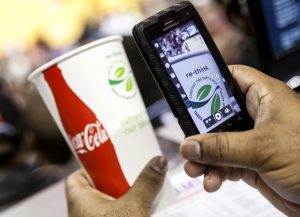
Given that many people tend to gradually consume a beverage, drinking cups provide an opportunity for consumer education.
“We call it the ‘two second critical moment of choice’ — when a fan has something in their hands that they think is trash, and we want them to think of it as a natural resource,” explains Davies. Colocating collection bins for recycling, composting and trash, complemented with signage that is a mixture of words (in whatever languages are most relevant) and images or representations that depict the actual products fans have in their hands are two strategies that have been effective at achieving this type of fan education. “It seems obvious when you see the signs and the bins together, but it is really not that obvious,” he adds. “We as a society do not have our heads wrapped around this — taking the two seconds is hard when you are shoulder to shoulder in a crowd being jostled toward the door.”
Messaging on the products themselves is another strategy that program implementers utilize to educate fans on proper disposal behavior. Although this strategy is not effective with all products, Davies notes that fans have more “intimate” interaction with some products over others, representing different opportunities for education. “People don’t have much of a relationship with packaging typically, but a cup is often different,” he explains. “Whatever you are drinking, you are drinking it for a while, and this provides a chance to do consumer education. We have done this with Coca-Cola® and its compostable cold cup. It has a whole panel on its side that explains about the cup and is intended to engage the consumer about what it is made of and why it is compostable. This may sound odd, but think about a cup compared to a candy wrapper, or the tray that holds your hot dog!”
Fan engagement and education have been an essential part of the Alliance’s undertaking since the very beginning. “We have hosted a number of webinars, Summit panel discussions, and workshops all focused on the topic of fan engagement,” explains Tull. “Our overall focus is always: How do you communicate about environmental initiatives in a way that doesn’t interfere with the fans’ game experience but is also really inspiring?”
Case Studies
A critical element in promoting greening initiatives in sports is documenting the work that has been done, and utilizing these records as models for other venues that are interested in adopting programs of their own. When the Alliance was founded, all six teams were based in the Pacific Northwest. But as evidenced by new members all over the nation, this is no longer the case. “Compostable products used to be seen as a Pacific Northwest thing, but we now have great proof points from the Midwest in Minnesota to Pennsylvania with the Pittsburgh Pirates, Penn State and Philadelphia Flyers,” explains Davies. “These proof points take off the table one misperception — that the trend in use of compostable food serviceware at sports venues [and in general] isn’t national.”
Case studies generated from these proof points are a great tool when reaching out to sports venues about alternative waste disposal initiatives. “Case studies take an abstract discussion and make it real,” states Davies. “As they say, ‘Imitation is the sincerest form of flattery’. There is no better example than to show somebody has done this and it has worked.”
Along with examples like the NRDC’s “Game Changer” reports, the Alliance produces case studies of its own. “We have developed case studies around solutions at sports venues,” notes Tull. “Case studies are one way the Alliance helps to share better practices and assist members with procurement. Case studies show how recycling and composting programs involving compostable serviceware could function in many other venues.”
Unified Mission
In just three years, the Green Sports Alliance has exhibited the power of an organization with a unified mission, building on the groundwork laid by NRDC’s sports greening initiatives, and taking on an industry that many never associated with sustainability or environmental awareness. By taking the business approach, and being conscious not to radically change the status quo, the Alliance has been able to instill change that has positive repercussions throughout our society. “I think it is important for teams and facility operators to note that their peers are saving millions of dollars, getting good visibility in their community, and reducing environmental impact by adopting greening strategies,” Tull stated towards the end of our discussion. “We would like to see every sports facility in North America and beyond make it a priority to understand their environmental impact, adopt strategies to minimize those impacts, and allocate staffing to make the greening programs successful.”


